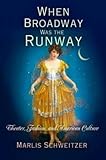When Broadway Was the Runway : Theater, Fashion, and American Culture / Marlis Schweitzer.
Material type: TextPublisher: Philadelphia : University of Pennsylvania Press, [2011]Copyright date: ©2009Description: 1 online resource (320 p.) : 47 illusContent type:
TextPublisher: Philadelphia : University of Pennsylvania Press, [2011]Copyright date: ©2009Description: 1 online resource (320 p.) : 47 illusContent type: - 9780812221633
- 9780812206166
- Costume -- New York (State) -- New York -- History -- 19th century
- Costume -- New York (State) -- New York -- History -- 20th century
- Department stores -- New York (State) -- New York
- Fashion -- New York (State) -- New York -- History -- 19th century
- Fashion -- New York (State) -- New York -- History -- 20th century
- Theater -- New York (State) -- New York -- History -- 19th century
- Theater -- New York (State) -- New York -- History -- 20th century
- Literature
- HISTORY / United States / 20th Century
- American History
- American Studies
- Cultural Studies
- Literature
- 792.09747/109041 22
- PN2277.N5 S39 2009
- online - DeGruyter
- Issued also in print.
| Item type | Current library | Call number | URL | Status | Notes | Barcode | |
|---|---|---|---|---|---|---|---|
 eBook
eBook
|
Biblioteca "Angelicum" Pont. Univ. S.Tommaso d'Aquino Nuvola online | online - DeGruyter (Browse shelf(Opens below)) | Online access | Not for loan (Accesso limitato) | Accesso per gli utenti autorizzati / Access for authorized users | (dgr)9780812206166 |
Browsing Biblioteca "Angelicum" Pont. Univ. S.Tommaso d'Aquino shelves, Shelving location: Nuvola online Close shelf browser (Hides shelf browser)

|

|

|

|

|

|

|
||
| online - DeGruyter Early Theological Writings / | online - DeGruyter Billy Graham and the Rise of the Republican South / | online - DeGruyter Afghanistan Declassified : A Guide to America's Longest War / | online - DeGruyter When Broadway Was the Runway : Theater, Fashion, and American Culture / | online - DeGruyter Beyond the Resource Curse / | online - DeGruyter Bodies and Books : Reading and the Fantasy of Communion in Nineteenth-Century America / | online - DeGruyter Liberty of the Imagination : Aesthetic Theory, Literary Form, and Politics in the Early United States / |
Frontmatter -- Contents -- Introduction -- Chapter 1. The Octopus and the Matinee Girl -- Chapter 2. The "Department Store Theater" and the Gendering of Consumption -- Chapter 3. "The Cult of Clothes" and the Performance of Class -- Chapter 4. Fashioning the Modern Woman -- Chapter 5. The Theatrical Fashion Show on Broadway and Sixth Avenue -- Epilogue -- Notes -- Index -- Acknowledgments
restricted access online access with authorization star
http://purl.org/coar/access_right/c_16ec
Selected by Choice magazine as an Outstanding Academic TitleWhen Broadway Was the Runway explores the central and largely unacknowledged role of commercial Broadway theater in the birth of modern American fashion and consumer culture. Long before Hollywood's red carpet spectacles, Broadway theater introduced American women to the latest styles. At the beginning of the twentieth century, theater impresarios captured the imagination of their largely female patrons by transforming the stage into a glorious site of consumer spectacle.Theater historian Marlis Schweitzer examines how these impresarios presented the dresses actresses wore onstage, as well as the jewelry and hairstyles they chose, as commodities that were available for purchase in nearby department stores and salons. The Merry Widow Hat, designed for the hit operetta of the same name, sparked an international craze, and the dancer Irene Castle became a fashion celebrity when she anticipated the flapper look of the 1920s by nearly a decade. Not only were the latest styles onstage, but advertisements appeared throughout theaters, in programs, and on the curtains, while magazines such as Vogue vied for the rights to publish theatrical costume sketches and Harper's Bazaar enticed readers with photo spreads of actresses in couture. This combination of spectatorship and consumption was a crucial step in the formation of a mass market for consumer goods and the rise of the cult of celebrity.Through historical analysis and dozens of early photographs and illustrations, Schweitzer aims a spotlight at the cultural and economic convergence of the theater and fashion industries in the United States.
Issued also in print.
Mode of access: Internet via World Wide Web.
In English.
Description based on online resource; title from PDF title page (publisher's Web site, viewed 24. Apr 2022)


